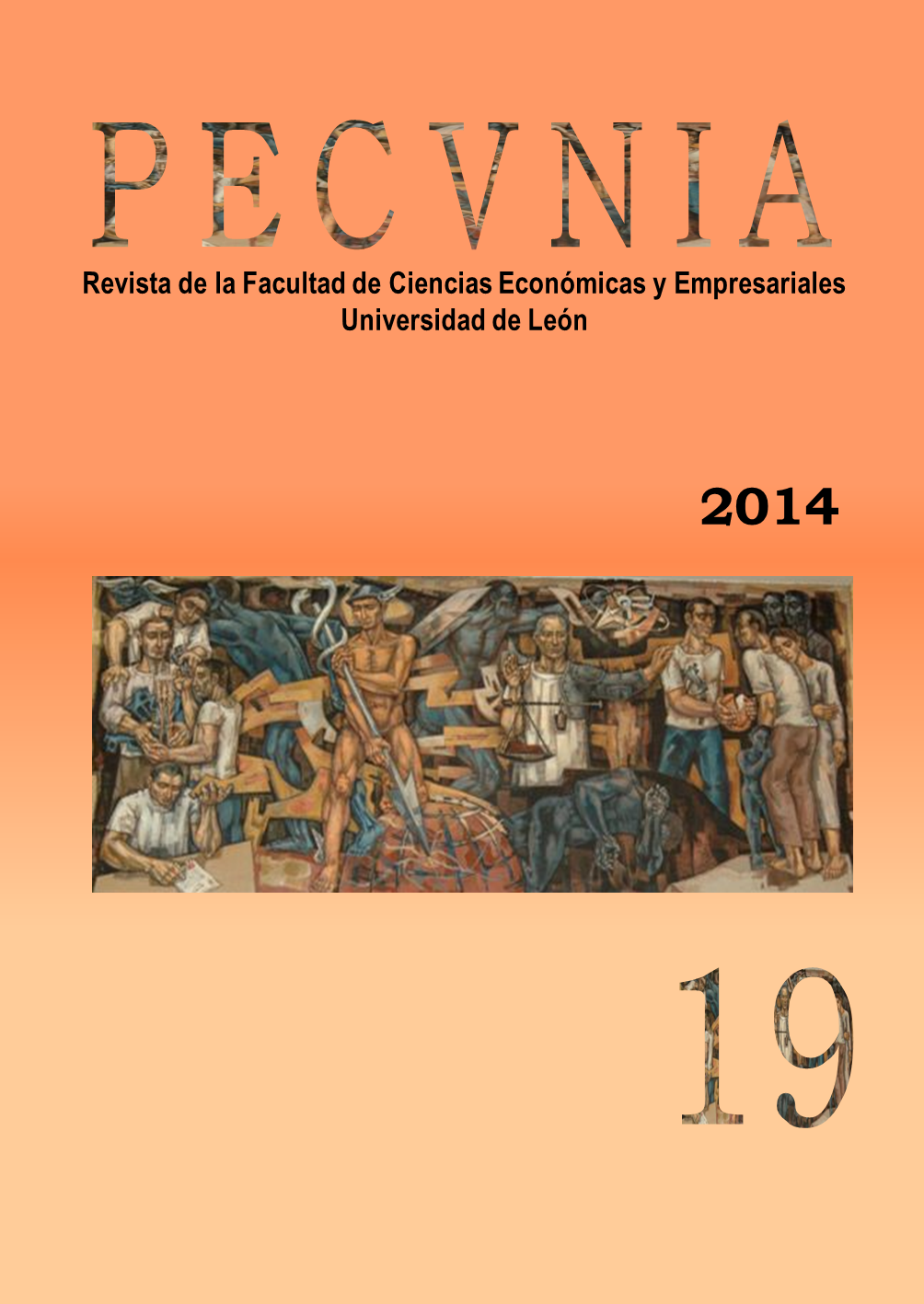Detección de indicios de manipulación contable y posible práctica “fraudulenta” en el gremio del comercio textil de Londres en los siglos XIV y XV = Evidences in detection of accounting manipulation and potential “fraud” in the textile industry in London during the 14th and 15th centuries
DOI :
https://doi.org/10.18002/pec.v0i19.3580Mots-clés :
Contabilidad, Fraude, Historia, Accounting, Fraud, HistoryRésumé
El gremio del comercio textil de Londres es una institución con más de 710 años de historia que todavía sigue ejerciendo su actividad. Desde el siglo XIV dispone de registros contables detallados que reflejan su actividad económica. Este trabajo pretende obtener indicios de manipulación contable en dicha institución mediante técnicas forenses (Ley de Benford) en el periodo 1390-1435. La aplicación de esta técnica ha puesto de manifiesto la existencia de indicios de una posible manipulación contable que confirma la existencia de prácticas “fraudulentas” (pagos a un parlamentario, alcalde…).
The Mercers’ of London is an institution with more than 710 years of history which is exercising still today. Since the XIV century it has kept thorough accounting records showing its economic activity. This paper’s goal is to obtain indications of accounting manipulation in this institution during the period 1390 to 1435, by using forensic techniques (Benford’s Law). The use of this technique has revealed the presence of indications of a possible accounting manipulation, which confirms the existence of ‘fraudulent’ practices such as payments to a MP and the mayor of London.
Téléchargements
Références
Benford, F. (1938). The law of anomalous numbers. Proceedings of American Philosophical Society, 78(4), 551–572.
Caunedo del Potro, B. (2003). Algunas consideraciones sobre los libros de cuentas. El tratado del licenciado Diego del Castillo. Historia, Instituciones y Documentos, (30), 145–157.
Creaton, H. (1976). The wardens’ accounts of the mercers company of London 1347, 1391-1464.Unpublished MPhil Disertation. University of London.
Davies, M. (2004). Lobbying parliament: The London companies in the fifteenth century. En L. Clark (Ed.), Parchment and people: parliament in the middle ages. Parliamentary History (23, pp. 143-48). Edinbourgh University Press.
Del Castillo, D. (1542). Tratado de cuenta hecho por el licenciado Diego del Castillo natural de la ciudad de Molina (2ª ed.). Salamanca: Imprenta de Juan de Junta.
De Texeda, G. (Ed.). (1807). Las Siete partidas del rey don Alfonso el Sabio, cotejadas con varios códices antiguos por la real academia de la historia (1807). Madrid: Imprenta Real.
Fiscalia General del Estado (2014). Memoria elevada al Gobierno de S.M. presentada al inicio del año judicial 2015. Consultada el 03-01-2015 en https://www.fiscal.es/fiscal/publico/ciudadano/documentos/memorias_fiscalia_generalestado/?selAnio=2014
Gonzalo de las Casas, J. (1853). Diccionario general del notariado de España y Ultramar (tomo 3). Madrid: Imprenta de la Biblioteca del Notariado.
Granada, L. (1994). Libro de la oración y meditación (1559). Obras completas (tomo 1). Madrid: Fundación Universitaria Española.
Hazlitt, W.C. (1892). The livery companies of the city of London: Their origin, character, development, and social and political importance. London: Swan Sonneschein and Co.
Hill, T.H. (1995). The significant-digit phenomenon. The American Mathematical Monthly, 102(4), 322–327.
Imray, J. (1969). Les bones gentes de la merceriye de Londres: A study of the membership of the medieval mercers company (pp. 155-78). En, A. Hollaender and W. Kellaway (Eds.), Studies in London History, presented to Philip Edmund Jones. Londres: Hodder & Stoughton.
Jefferson, L. (2009). The medieval account books of the mercers’ of London (vol. 1, pp. 16-17). Aldershot: Ashgate Publishing Co.
Jócano y Madaria, S. (1793). Disertación crítica y apologética del arte de llevar cuenta y razón. Madrid: Oficina de D. Gerónimo Ortega y Herederos de Ibarra.
Jouanique, P. (1987). La regla quien recibe, debe: una herencia de antigua raigambre en la contabilidad moderna. Técnica Contable, XXXIX(457-468), 247–258.
Mebane, W.R. (2009). Note on the presidential election in Iran, June 2009. University of Michigan. 29-09-2009. Consultado el 16-10-2014 en http://www-personal.umich.edu/~wmebane/note29jun2009.pdf
Miller, I. y Freund, J.E. (1963). Probabilidad y estadística para Ingenieros. Barcelona: Reverté.
Newcomb, S. (1881). Note on the frequency of use of the different digits in natural numbers. American Journal of Mathematics, 4(1), 39–40.
Nigrini, M.J. (2012). Bendford’s law: Aplications for forensic accounting, auditing and fraud detection. New Jersey: John Willey & Sons.
Parker, J. (1980). The book of ordinances of the mercers’ company of London. Unpublished MPhil Disertation. University of London.
Rotuli Parliamentorum ut et Petitiones et Placita in Parliamento (1783). J. Strachey et al . (Ed.), Vol. IV, 376-77.
Sutton, A. (1998). The silent years of london guild history before 1300: The case of the Mercers. Historical Research, 71(175), 121-41.
Sutton, A. (2005). The mercery trade and the mercers’ company of London from the 1130s to 1348. Unpublished MPhil Disertation. University of London.
Towson, D. (2004). Breve historia de Inglaterra. Madrid: Alianza.
Villaluenga, S. (2013). La partida doble y el cargo y data como instrumentos de un sistema de información contable y responsabilidad jurídica integral, según se manifiesta en fuentes documentales de la Catedral de Toledo (1533-1613). Revista de Contabilidad, 16(2), 126-
Vlaemminck, J.H. (1961). Historia y doctrinas de la contabilidad. Versión española, revisada y ampliada por J.M. González Ferrando. Madrid: EJES
Téléchargements
Publiée
Comment citer
Numéro
Rubrique
Licence
(c) Tous droits réservés Ángel Ballarín Garnica 2014

Ce travail est disponible sous licence Creative Commons Attribution - Pas d’Utilisation Commerciale - Partage dans les Mêmes Conditions 4.0 International.
Los autores que publican en esta revista están de acuerdo con los siguientes términos:- Los autores ceden de forma no exclusiva los derechos de explotación (reproducción, distribución, comunicación pública, transformación) a la Universidad de León, por lo que pueden establecer, por separado, acuerdos adicionales para la distribución no exclusiva de la versión de la obra publicada en la revista (por ejemplo, alojarlo en un repositorio institucional o publicarlo en un libro), con un reconocimiento de su publicación inicial en esta revista.
- Este trabajo se encuentra bajo la Creative Commons Attribution-NonCommercial-ShareAlike 4.0 International License. Puede consultarse desde aquí la versión informativa y el texto legal de la licencia.
- Se permite y se anima a los autores a difundir electrónicamente las versiones pre-print (versión antes de ser evaluada) y/o post-print (versión evaluada y aceptada para su publicación) de sus obras antes de su publicación, ya que favorece su circulación y difusión más temprana y con ello un posible aumento en su citación y alcance entre la comunidad académica.












